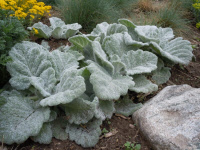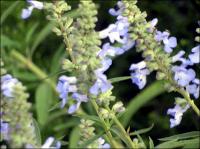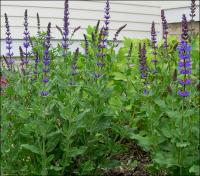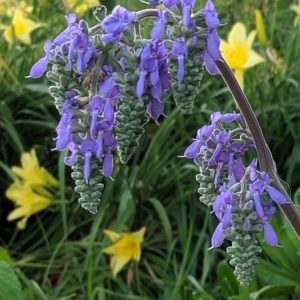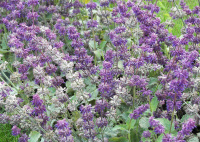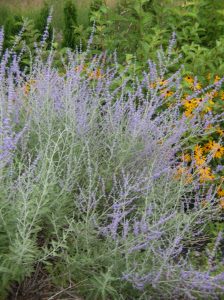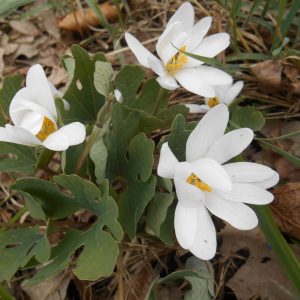Deer Resistant Plants
Showing 121–128 of 163 results
-
Salvia argentea Silver sage Biennial or short lived perennial Z 5-7
Large rosettes of the woolliest silver leaves. So soft you want to pet them. Grow this for the leaves, not the flowers. It dies after flowering so cut back flower stems to prevent flowering, or, if you want to save seeds let it flower. It self-seeds sometimes.
Large rosettes of the woolliest silver leaves. So soft you want to pet them. Grow this for the leaves, not the flowers. It dies after flowering so cut back flower stems to prevent flowering, or, if you want to save seeds let it flower. It self-seeds sometimes.
LIMITED QUANTITIES AVAILABLE, LIMIT OF 1 PER CUSTOMER.
Size: 2-4’ x 12"
Care: Sun in well-drained soil.
Native: Europe & No. Africa around Mediterranean
Awards: Royal Horticultural Society Award of Garden Merit; Plant Select® Central Rocky Mountain regionSalvia is from the Latin “salveo” meaning “to heal” referring to the plant’s ancient medicinal uses. Collected before 1750. The Garden reported it was introduced in 1768. Liberty Hyde Bailey said its, “white woolly foliage makes it a very decorative plant.” (1933).
-
Salvia azurea ‘Grandiflora’ Blue sage, Prairie sage Z 5-9
August – October sky blue flower clusters at a time dominated by russet. One of internationally known garden designer Piet Oudolf’s 100 “MUST HAVE” plants, Gardens Illustrated 94 (2013)
August – October sky blue flower clusters at a time dominated by russet. One of internationally known garden designer Piet Oudolf’s 100 “MUST HAVE” plants, Gardens Illustrated 94 (2013)
Size: 4’ x 24-36”
Care: Sun, moist well-drained soil
Native: Southeastern U.S., Wisconsin native
Wildlife Value: Primarily long tongued bees such as Bumble bees visit and pollinate the plants. Host for caterpillars of Hermit Sphinx butterflyNative Americans roasted or popped the seed of Blue sage as a grain. American garden cultivation since 1700’s. William Robinson, father of the mixed perennial border, praised this as “one of the finest (perennials from North America) in its flowers, borne as dense spikes of a beautiful pale blue during September and October.”
-
Salvia nemorosa Meadow sage, Balkan clary Z 5-7
Purple/lavender spire dense with flowers June to September
Dense purple spires flower June to September (if cutback after 1st flush of flowers).
Size: 36" x 24"
Care: full sun in moist well-drained to well-drained soil. Drought tolerant.
Native: Europe to Central Asia.
Wildlife Value: attracts butterflies & hummingbirdsSalvia is from the Latin word salveo meaning “to heal” referring to the plant’s ancient medicinal uses. Collected before 1753.
-
Salvia nutans Nodding sage Z 5-8
Nodding clumps of sky blue flowers high over basal leaves, flower in late spring-early summer.
Nodding clumps of sky-blue flowers high over basal leaves, flower in late spring-early summer.
Size: 3-4’ x 18”
Care: sun to part shade in moist, well-drained soil.
Native: Balkans
Wildlife Value: attracts bees & butterflies seeking pollen and nectar. Deer resistant.Collected before 1753. Introduced to gardens in 1780 by Peter Simon Pallas (1741-1811) Berlin botanist who collected extensively in Russia. Grown in nursery of Joseph Knight, King’s Road, London. Pictured in Curtis’s Botanical Magazine Vol. 50, 1822.
-
Salvia verticillata Lilac sage, whorley clary, Salbey Z 5-8
Muted lilac blue spikes June to October
Lillac flowers encircle erect stem spikes interspersed with bare, purple stems. June to October, deadhead for more blooms.
Size: 24” x 18-24”
Care: sun in moist well-drained to well-drained soil. Cut back after 1st bloom to repeat.
Native: Spain to Ukraine, Caucasus to Iran
Wildlife Value: Butterfly and bee magnet. Deer resistantSalvia is from the Latin “salveo” meaning “to heal” referring to the plant’s ancient medicinal uses. This species collected before 1753. Grown at America’s 1st botanic garden, Elgin Botanic Garden 1811.
-
Salvia yangii syn. Perovskia atriplicifolia Russian sage Z 5-9
Whorls of sky-blue flowers cover innumerable stems and their many branches creating a blue cloud from July through October
Whorls of sky-blue flowers cover innumerable stems and their many branches creating a blue cloud from July through October
Size: 4' x 4'
Care: full sun in moist well-drained to well-drained soil, Heat and drought tolerant. Cut back in spring.
Native: Afghanistan
Wildlife Value: deer & rabbit resistant, Feeds bees and honeybees
Awards: Great Plant Pick Award from Elizabeth Carey Miller Botanical Garden and Perennial Plant Association 1995 Perennial Plant of the Year.Perovskia was named for V.A. Perovski, governor of a Russian province in central Asia around 1890. Introduced to American gardens in 1904. Recommended by English garden maven Gertrude Jekyll in 1908.
-
Sambucus canadensis syn. Sambucus nigra var. canadensis. Elderberry, American elderberry Z 3-9
In late spring to mid-summer lavish, fragrant flat-to dome-shaped clusters of flowers bloom above this arching, multi-stemmed shrub. Late summer into fall the multitude of flowers turn into purple-black, edible fruits, up to 2000 per cluster!
In late spring to mid-summer lavish, fragrant flat-to dome-shaped clusters of flowers bloom above this arching, multi-stemmed shrub. Late summer into fall the multitude of flowers turn into purple-black, edible fruits, up to 2000 per cluster!
Size: 5-12’ x spreading quickly by suckers. Best to grow as hedge, along a roadside, fence-line or forest edge.
Care: sun to part shade in moist to well-drained soil
Native: Americas east of Rocky Mountains south to Bolivia. Wisconsin native
Wildlife Value: branches and leaves make nesting sites and give cover for birds.. Many birds (including, Pheasant, Bluebird, Cedar waxwing, Cardinal, Mockingbird and others) as well as some mammals eat the sweet, but slightly bitter, fruit. It is a source of pollen for numerous bees and other insects.Collected before 1735. Native Americans made extensive use of this, Cherokee used it topically for boils, burns and infections and internally for rheumatism, fevers, dropsy, as a diuretic, and of course ate the berries. Costanoan made its hollow twigs into pipes, flutes and shafts for arrows. Several Natives infused the flowers and foliage with hot water to make steam baths. And many natives ate it, boiled it, jammed it, and added the fruit to cakes. Today people eat them in jellies, jams, pancakes, pies and wine and make homeopathic medicine from it. Reportedly ripe berries are high in vitamin C and fiber. It’s also an antioxidant.
**LISTED AS OUT OF STOCK BECAUSE WE DO NOT SHIP THIS ITEM. IT IS AVAILABLE FOR PURCHASE AT OUR RETAIL LOCATION.
-
Sanguinaria canadensis Bloodroot, Indian paint, Red Puccoon Z 3-9
Elegant, swan-white anemone-like blooms showcase bright yellow stamens in spring emerging from the center of glaucus,lobed, puckered, rolled leaves. Both the leaves and root contain a red sap. (Bloodroot). Ephemeral, dies back in summer.
Available for purchase in Spring only
Elegant, swan-white anemone-like blooms showcase bright yellow stamens in spring emerging from the center of glaucus,lobed, puckered, rolled leaves. Both the leaves and root contain a red sap. (Bloodroot). Ephemeral, dies back in summer.
Size: 6” x 12”
Care: part shade to shade in moist well-drained soil
Native: Nova Scotia to Manitoba, south to Florida and Arkansas, Wisconsin native
Wildlife Value: deer resistant. Pollen, but no nectar, makes this attractive to many different bees. Ants distribute the seeds.Sanguinaria is Latin meaning “blood,” so named for the red color of the sap. Natives used sap to make dye for skin, clothing, weapons, and baskets. Used to induce abortions, as well as an aphrodisiac and to cure sexually transmitted disease. The root rubbed on the palm of the hand was a love charm for Ponca men. Iroquois prescribed it for diarrhea and constipation, to draw out slivers, hiccups, and generally as a panacea. It was administered to those who saw a corpse. Sioux used a weak solution to cure fever, rheumatism, congestion, and skin cancer Ojibwa made dried roots into a necklace to prevent bleeding. Collected by Rev. John Banister in colonial Virginia c. 1678. According to Pennsylvania nurseryman John Bartram(1699-1776) this was “…(C)alled by the Country People, Red Root, or Tumerick The Root dried and powdered is recommenced by Dr. Colden, as a Cure for jaundice, the Powder has been given to the Weight of a Drachm in Small Beer; and by others, for the Bite of a Rattle Snake.” Grown at Shadwell, Jefferson’s birthplace and home until it burned in 1770. Grown at America’s 1st botanic garden, Elgin Botanic Garden 1811, located where Rockefeller Center now stands. Pressed specimen in Emily Dickinson’s herbarium.

